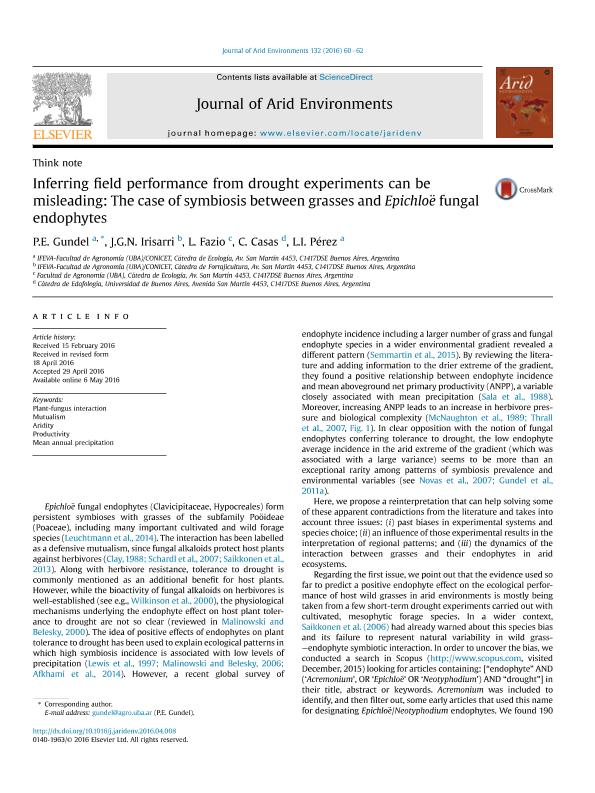Artículo
Inferring field performance from drought experiments can be misleading: The case of symbiosis between grasses and Epichloë fungal endophytes
Gundel, Pedro Emilio ; Irisarri, Jorge Gonzalo Nicolás
; Irisarri, Jorge Gonzalo Nicolás ; Fazio, Lucas; Casas, Cecilia
; Fazio, Lucas; Casas, Cecilia ; Perez, Luis Ignacio
; Perez, Luis Ignacio
 ; Irisarri, Jorge Gonzalo Nicolás
; Irisarri, Jorge Gonzalo Nicolás ; Fazio, Lucas; Casas, Cecilia
; Fazio, Lucas; Casas, Cecilia ; Perez, Luis Ignacio
; Perez, Luis Ignacio
Fecha de publicación:
09/2016
Editorial:
Academic Press Ltd - Elsevier Science Ltd
Revista:
Journal of Arid Environments
ISSN:
0140-1963
Idioma:
Inglés
Tipo de recurso:
Artículo publicado
Clasificación temática:
Resumen
Epichloe fungal endophytes (Clavicipitaceae, Hypocreales) form persistent symbioses with grasses of the subfamily Pooideae (Poaceae), including many important cultivated and wild forage species (Leuchtmann et al., 2014). The interaction has been labelled as a defensive mutualism, since fungal alkaloids protect host plants against herbivores (Clay,1988; Schardl et al., 2007; Saikkonen et al., 2013). Along with herbivore resistance, tolerance to drought is commonly mentioned as an additional benefit for host plants. However, while the bioactivity of fungal alkaloids on herbivores is well-established (see e.g., Wilkinson et al., 2000), the physiological mechanisms underlying the endophyte effect on host plant tolerance to drought are not so clear (reviewed in Malinowski and Belesky, 2000). The idea of positive effects of endophytes on plant tolerance to drought has been used to explain ecological patterns in which high symbiosis incidence is associated with low levels of precipitation (Lewis et al., 1997; Malinowski and Belesky, 2006; Afkhami et al., 2014). However, a recent global survey of endophyte incidence including a larger number of grass and fungal endophyte species in a wider environmental gradient revealed a different pattern (Semmartin et al., 2015). By reviewing the literature and adding information to the drier extreme of the gradient, they found a positive relationship between endophyte incidence and mean aboveground net primary productivity (ANPP), a variable closely associated with mean precipitation (Sala et al., 1988). Moreover, increasing ANPP leads to an increase in herbivore pres- sure and biological complexity (McNaughton et al., 1989; Thrall et al., 2007, Fig. 1). In clear opposition with the notion of fungal endophytes conferring tolerance to drought, the low endophyte average incidence in the arid extreme of the gradient (which was associated with a large variance) seems to be more than an exceptional rarity among patterns of symbiosis prevalence and environmental variables (see Novas et al., 2007; Gundel et al., 2011a).
Archivos asociados
Licencia
Identificadores
Colecciones
Articulos(IFEVA)
Articulos de INST.D/INV.FISIOLOGICAS Y ECO.VINCULADAS A L/AGRIC
Articulos de INST.D/INV.FISIOLOGICAS Y ECO.VINCULADAS A L/AGRIC
Citación
Gundel, Pedro Emilio; Irisarri, Jorge Gonzalo Nicolás; Fazio, Lucas; Casas, Cecilia; Perez, Luis Ignacio; Inferring field performance from drought experiments can be misleading: The case of symbiosis between grasses and Epichloë fungal endophytes; Academic Press Ltd - Elsevier Science Ltd; Journal of Arid Environments; 132; 9-2016; 60-62
Compartir
Altmétricas



